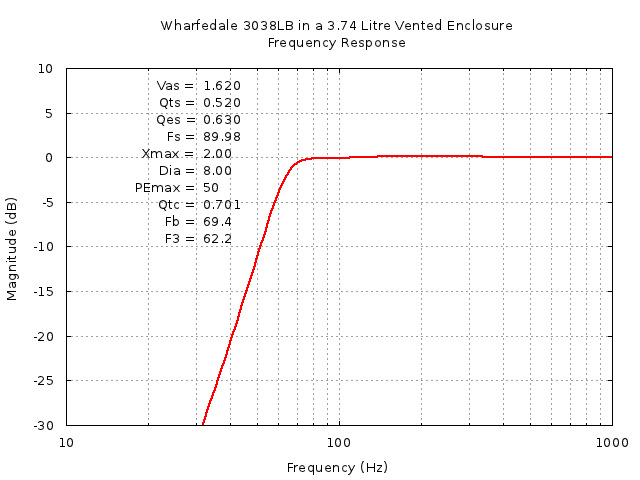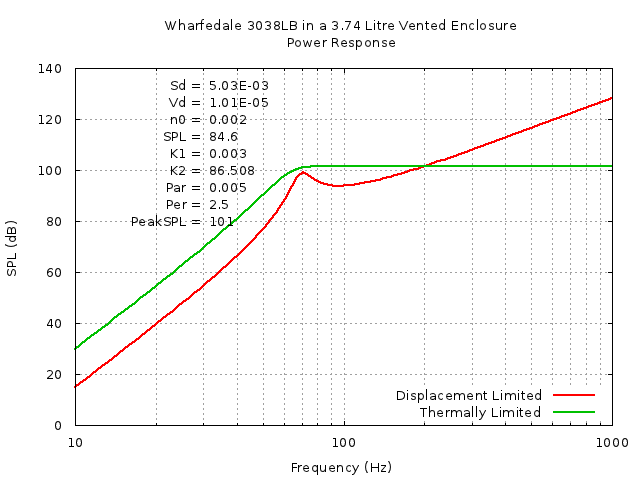Vented
Having had some success building a sealed box, the next challenge was to build a vented or bass reflex box.
Calculations
Again, gnuplot was put to work to generate a predicted response for my drivers, and help calculate the required volume of the box. The results are shown below. Please click on either graph to find the gnuplot code used to generate them.
By comparing this graph with the one for the sealed enclosure, it is evident that the bass response will be very different. Although the Fb is much lower at 69.4 Hz, the response drops off much faster below that point. Will it sound better? That is a question we will find out soon. Some more MDF is waiting to be turned into the MK-II speakers.
Before I dive in, and start cutting wood, some more details need to be worked out. We have the size of the box. At 3.74 litres, they will be a bit larger than the last two, but we still need to know the size of the port before we can calculate the internal volume.
Port Calculations
If some pipe was available, that would govern the diameter of the port, and the length would be calculated from that. As some pipe is not available, a slot port is going to be used.
First, we need to decide on the cross sectional area of the port. Using the calculations from here, the minimum diameter of the port can be is 2.23 cm. Alternatively, we can use a slot port with a cross sectional area of 390 mm².
In order to do some calculations, I need to make a start, and pick out some numbers to use until a clearer picture starts to form. So, the port will be 3.00 cm internal diameter, or equivalent rectangular port. So with this diameter, the port length calculates to be 9.58 cm long.
Now, if I have a diameter for the port, the following equation can provide the short edge of an equivalent rectangular port, where the long edge will equal the short edge multiplied by the Golden Ratio
So for our port we will have a short edge of 2.09 cm, and a long edge of 3.38 cm.
Whatever the port size, the dimensions for the box also need to be calculated to find the available size, and see if the port above will even fit inside the box.
A similar design to the sealed box will be used where the internal dimensions are related by the Golden Ratio, 1.618.
| Internal | External | |
| Width | 98.0 | 134.0 |
| Depth | 158.6 | 194.6 |
| Height | 256.7 | 292.7 |
| Width | Length | |
| Front | 194.6 | 292.7 |
| Sides | 116.0 | 292.7 |
| Top & Bottom | 116.0 | 158.6 |
| Back | 158.6 | 256.7 |
Construction
Initially, to make things simpler, I intended to try and avoid too much routing with these speakers. I was going to try and just cut the panels to size with a circular saw, and then dowel the joints. Things did not go well. The saw does not leave the best finish to the edges of the MDF boards. Also, the dowel jig was not very good. As good as could be expected, considering how cheap it was. Finally, the day I did it was not a good day, and in my haste made a number of mistakes, including fitting the reflex port to the wrong panel.
From that mess, the front panel was salvageable. So new panels were cut for the tops, bottoms, sides and backs. This time, I fixed my little router to an old saw table, to use as a simple router table. This made sizing the boards much simpler. Also, I invested in a rebate cutter for the router. This, combined with the table, made cutting the joints so much simpler.
Listening
These sound really good. Eventually, I will make up a switch box so that I can flick between two sets of speakers to get a better comparison. However, I am quite pleased with how these sound. The bass response is better than the sealed box, as expected. The only thing is that there is probably a lack of treble. The quality of the sound from these cheap small drivers is quite impressive.
I will add some pictures to this in a few days.
The Next Step
A single driver in a bass reflex box does a fair job, but lacks some treble. My plan for the remaining twelve drivers keeps changing. But at the moment, I fancy building a pair of speakers using six drivers each plus a pair of tweeters. Four drivers will be in a ported enclosure for bass, two in a sealed enclosure for mid plus a tweeter.
I guess that it should sound OK, but it will also look cool, if all the drivers are arranged in a vertical line up the front of the box.
Another idea I had was to put all twelve drivers, as six isobaric pairs, into a 4th Order Band Pass sub woofer.

